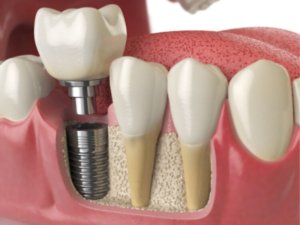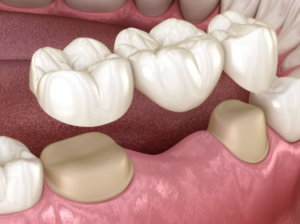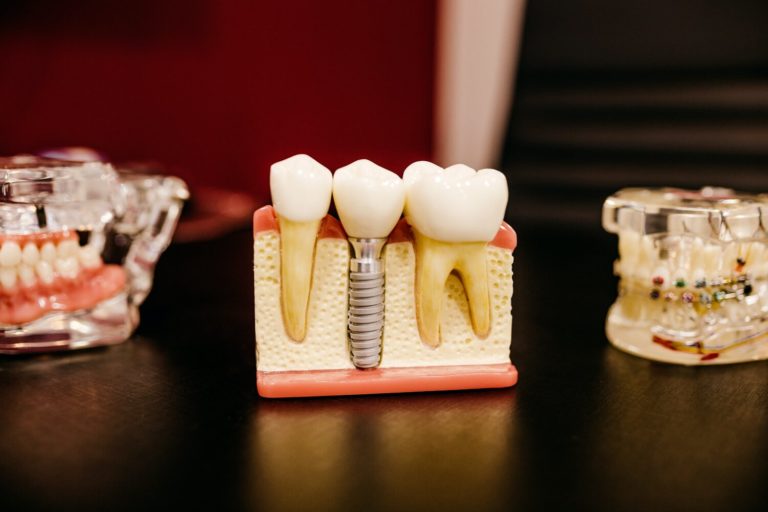Fort Collins Dental Implants
If you lose one or more teeth due to periodontal disease, or another cause, there is hope. Dental implants are designed to provide a foundation for replacement teeth that look, feel, and function like natural teeth. Dental implants provide the patient with the ability to eat virtually anything and can smile with confidence, knowing their teeth will appear natural and that facial contours will be preserved.
WHAT HAPPENS WHEN YOU LOSE A TOOTH?
When you lose a tooth, especially a back tooth, you may feel you don’t need to replace it, since no one can see that it’s missing and you have plenty of other teeth. However, there is more bone loss going on under the surface once a tooth is lost. Surrounding each tooth is an alveolar bone that supports the tooth and when the tooth is lost, that bone basically melts away. This is why people who have lost most of their teeth and are not wearing dentures appear to have a caved-in appearance to their mouths. Besides causing damage to the immediate area, tooth loss affects remaining teeth as well. Teeth create a structure for the face and their loss can shift the surrounding teeth, creating esthetic issues and bite problems. A lost tooth can also affect facial structures such as the jaw, muscles, jaw joints, and even the skin. If several teeth are lost, it’s not uncommon to suffer from social consequences and poor nutrition.
REBUILDING BONE
When the supporting alveolar bone melts away, it’s gone for good, but through grafting, a skilled dental professional can recreate bone to fuse with and support an implant. This is wonderful news, but it is still best to have a dental implant as soon as possible after the tooth is lost for the most predictable esthetic outcome.
TIMELINE
Replacing a tooth with an implant and a crown is not a one-day procedure. The implant needs time to properly adhere to the bone and create a healthy fusion before the crown can be attached and full bite force can be applied. In most cases, it will take a few months to complete the process. Due to the timeline, dental implants are actually a series of steps; each is very different. Click here for post-implant care instructions.
The key benefit of dental implants over other tooth replacement systems is that an implant connects directly to the jaw bone. It’s obviously not the same as the original connection, but functions just the same. When a tooth is lost, bone loss will eventually occur in that region because the root is no longer stimulating and stabilizing the bone. By using titanium–which biochemically joins to bone–to replace the root, you get a bond that more accurately replicates the one found in nature.
Schedule an Appointment
"*" indicates required fields
By submitting the form above, you consent to receive SMS text messages from Northern Colorado Dental Specialty and Implant Center for appointment reminders, marketing messages, and general two-way communication. Msg frequency varies. Msg&data rates may apply. Reply HELP for support. Reply STOP to opt out.
Dental Implants vs. Dental Bridges
IMPLANTS
Dental implants are a series of procedures used to recreate a missing tooth. The key part of a dental implant is the initial titanium implant which sits in the original tooth’s bone pocket, or alveolus. The titanium works well with the bone and actually forms a bond with it over time, much like the original bond between the tooth and the jaw bone. This is essential as it prevents bone loss that would normally occur with any other type of tooth replacement. Dental implants are capped with a crown, which replicates the enamel or visible portion of a tooth, and in many cases the replacement tooth will work just as well, if not better, than the original tooth.

BRIDGES
A fixed dental bridge is a non-removable prosthesis attached to remaining natural teeth.The false tooth or teeth literally bridge the gap between natural teeth. For a long time, fixed bridges were the best alternative for people who had lost teeth, as they were quite successful and esthetically pleasing. Unfortunately, bridges can also present some problems because the natural teeth that lie on either side of the bridge are filed to accept the appliance. This step in the bridge-making procedure may make these teeth prone to bacterial plaque accumulations, decay, periodontal disease, and the possible need for future root canals.

COST BREAKDOWN: IMPLANT VS. BRIDGE
At first glance, it appears that a bridge is the more economical route, with total fees for a typical implant starting at the top end of the cost for a fixed bridge and ending a couple thousand dollars higher. But when comparing cost versus value, the dental implant is more cost-effective and the better treatment option – if the patient is a candidate for implants.
All on 4 Dental Implants
Using the latest technology and dental practice techniques, All-on -4® gives you a permanent set of new teeth that perform similar to natural teeth. No matter the condition of your teeth, All-on -4® can restore your smile. The process is all done at one location and can be completed in mere hours.
- Extraction of damaged tooth or teeth
-
Jawbone preparation (grafting), if necessary
-
Placement of dental implants
-
Bone growth and healing
-
Placement of implant abutment
-
Placement of artificial tooth


